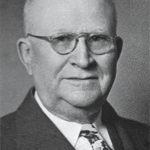Description
The Pacific Garden Mission
A Doorway to Heaven
BY
CARL F. H. HENRY
I N T R O D U C T I O N
By H. A. Ironside, Litt.D.
2016
Contents
INTRODUCTION 7
PREFACE 11
I. DOORWAYS TO HEAVEN AND HELL 12
II. GOD’S FLOPHOUSE 18
III. THE ANGEL OF THE SLUMS 24
IV. THE SHIFT TO PACIFIC BEER GARDEN 28
V. FROM COUNTERFEITING TO REALITY 36
VI. LOADING THE BASES ON THE SAWDUST TRAIL 40
VII. MEL TROTTER’S SUICIDE NIGHT 46
VIII. A CRADLE OF AMERICAN EVANGELISM 50
IX. THE GREAT TRIUMVIRATE 63
X. IN THE SHADOW OF THE MISSION MOTHER 78
XI. A TWENTIETH-CENTURY JONAH 88
XII. FIVE FEET FIVE INCHES OF SNOW 92
XIII. PORT OF MISSING MEN 98
XIV. CALVARY COVERS IT ALL 103
XV. A BOX SEAT ON “MURDERER’S ROW” 112
XVI. RELICS OF THE PAST 118
XVII. THE APOSTLE OF STATE STREET 122
XVIII. THE MAN WHO HEARD GOD LAUGH 129
XIX. TRIMMING THE LOWER LIGHTS 133
XX. FOLD OF THE LOST SHEEP 139
DEDICATED TO
Long Island’s “Mother Christy,”
who first pleaded with the author
to receive Christ as Savior
“Doorway to Heaven”
Interior of the “P. G.” Missions
Chicago’s Ill-Famed State Street
INTRODUCTION
Those who have decided that the age of miracles has long gone by will do well to read and ponder over this amazing record, of sixty-five years of Mission history, in a great city and in the midst of its very worst section morally. That the Gospel of Christ has lost nothing of its old-time virility but that it is still the dynamic of God unto salvation to every one that believeth is here proven to a demonstration. In a masterly way the gifted author has presented a panorama of regeneration – a moving picture of the redeeming value of the blood of Christ and the life-giving energy of the Holy Spirit, manifested in the salvaging of human wreckage and the new creation of utterly lost men and women, – transforming drunkards, gamblers and criminals of all types into devoted saints of God and hard-toiling servants of the Lord of glory, whose delight is to seek to bring others to know Him who has wrought so mightily on their own behalf.
If the Pacific Garden Mission had been the spiritual birth-place of only a few outstanding converts such as Harry Monroe, Billy Sunday, Melvin A. Trotter, Edward Cord, Bill Hadley and Walter McDonald, it would be worth all the money and labor expended through the two-thirds of a century of its existence. But here we read of scores of degraded sinners transformed into conscientious and upright children of God, through the miracle of the new birth which alone enables one to enter into and enjoy the blessedness of the Kingdom of God.
For more than thirty years it has been my own privilege to drop into the Mission occasionally, to be thrilled by the testimonies of its happy converts whose joy in their deliverance from the bondage of sin often beggars all description. It was in the old days, years ago, before the railways merged and took over all the express companies that I heard an old man with a shining face exclaim, “My friends, Wells Fargo and Company’s Express couldn’t have expressed my feelings the night God saved me and the load of guilt and sin was lifted from my heart.” It was oddly put, but the reality of a great deliverance from a terrible thralldom was behind it all. And this has been true, and is true today, of hundreds, yes thousands, who have knelt at the old fashioned mourner’s bench or penitent-form at the “altar” of the Pacific Garden Mission and there met the Eternal One who says, “Look unto me and be ye saved, for I am God and there is none else.” Revealed in Christ Jesus, whose name means literally Jehovah the Savior, He has manifested His deep personal interest in all who bow before Him in repentance and call upon Him in faith.
This book is the best answer to the specious sophestries and, as some think conclusive arguments, of infidelity and atheism I have ever seen. These men know there is a God for they called upon Him and He responded to their cry. Like the once-blind man of whom we read in John 9, they exclaim as with one voice, “Whereas once I was blind now I see.” And they know that no power but that of God could ever have wrought so great a change.
It is safe to say that no perversion of the gospel such as that offered in modernistic pulpits today could ever effect such transformations as we read of here. In the Pacific Garden Mission there has been no place through all the years of its existence for any other than the old-fashioned preaching of the three R’s – Ruin, Redemption and Regeneration. Its preachers and converts alike could ever sing
“I have no other argument,
I want no other plea,
It is enough that Jesus died
And that He died for me.”
This gospel demonstrates its divine origin and its inspired character by what it does. Paul could say, “I am not ashamed of the gospel of Christ for it is the power of God unto salvation to every one that believeth… for therein is the righteousness of God revealed from faith to faith as it is written, The just shall live by faith” (Romans 1:16,17). In the evangelical churches and missions everywhere the proof of this is evidenced, and this has been specially true in the record of these years of testimony for Christ of the Pacific Garden Mission, and the effectiveness of the many evangelists who were there brought to know Him whom to know is life eternal. Saved themselves, many of them have gone forth through the length and breadth of this and other lands carrying the same message to uncounted millions and leading vast numbers to the Saviour who met them in their hopelessness and wretchedness and revealed Himself to them as the Almighty Deliverer. These men were themselves exemplifications of the Great Physician’s power to heal sin-sick souls, to renew blighted lives, to bind up broken hearts and to lift from the lowest depths of despair to the highest heights of blessing. The story of this Mission and its converts is a new chapter in the Acts of the Holy Spirit proving that Jesus Christ is indeed the same yesterday, today, and forever.
No one who is even slightly familiar with the work and testimony of the Pacific Garden Mission will question the accuracy of the story here set forth. Rather, he will exclaim with Sheba’s queen, “The half hath not been told.” It would not be possible to inscribe in a book the greatest triumphs of this work, for they are of so sacred a character that human language could not portray or express them aright. They are among those spiritual things which are spiritually discerned. If all the details of those sixty-five years were to be put down on paper, so far as it is possible to describe them, it would take more than the Library of Congress to house the books that would have to be written. Only eternity will reveal all that the work of Col. and Mrs. Clarke and their successors has meant to poor sin-laden humanity for whom Christ died.
Nor were these poor derelicts the only ones benefited by contact with this great work. Some of the ablest preachers and teachers of the Word were trained to a large extent in the Pacific Garden Mission. Perhaps there is no greater expounder of Scripture in America than Dr. William Evans, who is internationally known and whose messages have been blessed to thousands in this and many other lands. As a student of the Moody Bible Institute, young Evans led the singing and played a cornet at the Mission and later served for two years as an assistant to Harry Monroe. He counts the time spent in that work as part of the schooling that fitted him for his later worldwide ministry.
It has been my privilege to know many of those mentioned in this volume. I have seen the grace of God leading them on in Christ’s triumph. I have recognized their lowly, self-sacrificing interest in others who are still where they once were. I have noted their dependence on God, and have been moved by their simplicity as they went to Him in prayer, believing He meant what He said when He bade them be not anxious about anything, but in everything by prayer and supplication with thanksgiving make known their requests. And I know they were upheld by the Hand of Omnipotence which they grasped in faith as they knelt at the cross. Theirs’s has been a real salvation from real sin and wickedness.
But I must not attempt to hold anyone longer at the door. Open and enter in and see for yourself this great galaxy of those who have surrendered to the cross of Christ. And as you move on through these stirring chapters you will find yourself exclaiming with awe and reverence “What hath God wrought!”
- A. IRONSIDE, LITT. D.
PREFACE
Pacific Garden Mission is the meeting place of two worlds. If it is true, in general, that half of the world does not know how the other half lives, this salvaging station has been an exception. For sixty-five years it has snatched prospective saints from the brink of hell.
There are evangelists, pastors, mission workers and Christian laymen by the thousands who trace their first impulse to surrender their lives to Christ to this mission. More than thirty thousand converts have found Jesus Christ in the shadow of this sanctuary. Today they are respectable members of society and the business world; the degradation and destitution of earlier years is but a memory.
The record of this mission, oldest in the northwest and second oldest in the nation, for reclaiming the humanly incorrigible, makes a factual epic more thrilling than any of the world’s fancies.
CARL F. H. HENRY.
I. DOORWAYS TO HEAVEN AND HELL
Chicago’s Loop, like the heart of any huge city, three steps from heaven and-two steps from hell.
It was a bristling evening in May, Rough and ready, clad in old clothes like any man of the streets, I wandered aimlessly through the Loop. Into the shifting, eyes of down-and-outers who sauntered by, I looked with conscious effort to feel the emotions of men whose feelings are jaded, and to think the thoughts of men too tired to think.
It was no easy job, this business of a preacher being a bum, even for a night or two.
Colorless, empty, bleary eyes. Heavy, lazy, tired feet. Workers, homeward-bound, after a day’s work. Businessmen hurrying to a cab or to the elevated. Homeless outcasts. Wandering refugees. Drink and drug addicts. Philanthropist and harlot, millionaire and ethnographer walking the same streets.
From Madison, I shuffled southward on State street, banked on either side by the shopping district that brings throngs to showrooms and counters. There was Kresge’s, Walgreen’s, Grant’s, and, as I neared Adams, the rear annex of the famed Palmer House, and then the Fair. Newsstands, traffic lights and street corners were passed with monotonous succession, as also the unending chain of stores: Woolworth’s, Howard’s, Benson and Rixon’s, Hilton’s, the Hub, and then Jackson boulevard; Rothschild’s, Goldblatt Brothers, and then Van Buren street with the elevated circuit that encloses the Loop. Just inside that circuit, as night fell, glittered the flickering lights of the Rialto, heralding a giant stage revue, the world’s greatest show, and, as a Saturday night special at 12:05, “Paris in Chicago.”
Those words were the first tangible evidence that State street’s “500 block” was just ahead. City within a city, it is the fair ground of burlesque and 30-cent a night hotels, pawn shops and women barbers, bar-rooms and cut-rate stores, gloomy dens and greasy lunch counters that still feature a hot dog or a hamburger on a bun for a nickel. Just one step from the Loop, and opposite the modern Sears’ department store which extends a block long from Van Buren to Congress, flows this weird mixture of two worlds. White men, black men, yellow men surge in and out of the changing crowds. The best of men and the worst of men, the best of women and the worst of women are there. Strangers hurry through the throngs to the Dearborn-Polk Street Station for trains to eastern Canada and the southwest, unaware that plain clothes detectives patrol the streets.
Hera young couples wander and old men shuffle into burlesque houses, lured inside by strip tease billboards displaying immodest women. Down State street walks a stunningly dressed butterfly, with a graceful rhythm and an inviting air. Not until she turns into the burlesque house for the nightly performances is it apparent that expert facial decoration has sheared ten or fifteen years from the world view, but not from the heart.
Outside the customers slide their two dimes through the ticket window to the gray-haired woman cashier and then trickle inside. At the State-Harrison, beautiful Ann Corio furnishes the week’s attraction in “Swamp Woman,” with “Guilty Parents” scheduled for an early appearance. Every Saturday night promises a midnight show. The lurid display signs of two other burlesque houses scream their features. “Unknown Blonde” is the attraction at one of them, and a taxicab arrives there with three girls and two sailors. State street is broken up with subway construction, so the pride of the navy convoys its cargo to the sidewalk pickaback. The crowd chuckles.
All the way from Russell’s Silver Bar at State and Van Buren to the State-Harrison Bar, the “500 block” is a seminary of sin with a sprinkling of ordinary businesses. Beyond Russell’s corner spot stands one of the omnipresent Thompson restaurants. Then the first “loan bank,” probably so dubbed to impress the paupers visiting the pawn shop that there isn’t so much sting in poverty after all, flaunts its welcome. Next comes the first “hotel,” with rooms as low as thirty-five cents. Between two men’s clothing shops – one with 15-cent neckties in the show window and the other modestly affirming itself the “largest retailers of pants in America” – stands Bradley’s Bar.
Just beyond another jewelry pawn shop vibrates the tumultuous jazz echo of the Club Cabana, with its red and green lights over the street windows, but no yellow for caution. A casual glance through the tilted blinds reveals that the crowd is merry and business is good, to desecrate the adjective.
Next is a game shop and lunch counter, where patrons munch a sandwich and gulp down a cup of coffee between target practice on wooden ducks and other mechanical contests, some of which call for skill and others for luck, but all of which require nickels, dimes and quarters. Still pictures of nude women for a penny a series and movie pictures of artists’ models for a nickel a run pack in the small change. A roly-poly colored boy, almost as wide as tall, runs back and forth between the penny arcade and the street window of the nearby Pink Poodle, a night club featuring “Puppets on Parade.” He presses his nose flat against the window, watches the dancer do her rhumba, mutters “She’s not so hot, even if she thinks she is,” and goes back to spend another penny.
Beyond the arcade are two more pawn shops and between them, with its hilarity concealed from the street world by super-decorated windows, Millie’s. Then comes another cheap hotel – rooms at thirty cents – and the Babette, where liquor flows freely. Next door is the thirty-cent Gem, first of the three slapstick burlesque houses as one walks south in this block. Street signs display half-naked women, and whatever sensuous appeal the photographers and artists have overlooked has been more than offset by sign-writers Who spare no superlatives to evoke trade. The ticket girl is unattractive and the barker, whose appearance fits him nicely into the regular society of the “500 block,” mumbles his announcements just unintelligibly enough to arouse the question whether he is deliberately attempting to evade being understood.
With mingled speeds the throng moves in all directions. The collection of human faces changes every few seconds, but it is none the less interesting. Old men and old women, mostly alone, sometimes in couples, bend over the street as they plod along. Middle-aged men and middle-aged women, their foreheads deeply lined with furrows, follow the path of least resistance through the crowd. Young people, some jolly, some tired, wind in and out, in search of a good time. Now and then they dart into a tavern, or into a recreation parlor, and then out into the streets again, Soldiers and sailors walk along leisurely; the nation is at war and this is their leave. They come with buddies, soldier with soldier and sailor with sailor, and sometimes they have found giggling companions for the night. Despite the early evening hour, men are already swaying on the streets like trees bending with the wind.
From across the street echo strange words and music for a land like this. A street meeting is in progress and a Chicago Tract Society group is singing “Wonderful Words of Life.” The theme comes with shocking suddenness to those who live intensely in the “500 block” without any life at all. Almost everything is peddled within hearing distance: liquor, dope, women.
A few hags – middle-aged women, unattractive despite layers of rouge – ply their trade as street walkers. Their story is more disgusting than that of the younger prostitutes for whom promoters, procurers and madams, not to mention taxi drivers and bellhops, discover prospects. Most any police station can tell the story of the prostitutes who pay occasional penalty in court, but not much is done about the operators who profit from the business, and who select the “right girls” to make a honky-tonk a popular resort. The policeman’s say-so sends a prostitute to jail for three to six monhs, but nobody gets the so-called “barrel of evidence” necessary to land a solicitor, madam, owner or promoter.
Most of these younger girls are neither professional nor successful prostitutes. They did not set up a girlhood ambition for venal lewdness. They became commercial prostitutes before they reached the decision. From a job as waitress in a low-class drinking joint they found it easy to make a few dollars occasionally while on dates with “nice fellows.” Then, confronted with an illegitimate child, or with sex delinquency for which neither psychiatric nor medical treatment is being provided, or beset with an impassioned desire for drugs and the necessity for money, they suddenly find themselves commercial prostitutes. Some of them even enjoy their association with small-time rackets and racketeers, which brings extra prominence. But few of them find prostitution so financially profitable that they engage a selected clientele; such girls are not found in the brothels and hovels of the slum districts. These are not the “hostess for a night” professionals for which some hotels have become infamous, but they are the low-grade, low-priced, unsuccessful prostitutes who are the greatest venereal disease menace. Their solicitors, clever middle-aged men who know how to overlook curious folks that obviously want to be solicited, know the poolrooms and dubious resorts where they can pick up delinquent youngsters.
There aren’t many red lights in the State street area now, and the number of prostitutes is smaller. The most obvious reason is that there aren’t as many prospects this year. There are fewer drifters and less men out of work, because these are war years, and the armed forces and defense plants have put all available hands behind triggers and machines. So the prostitutes, too, have been on the move to defense centers and other areas where lonely men are susceptible to commercially exploited women and girls.
Beyond the burlesque house is the entrance to the Yes-Yes Club, and then another pawn shop. Then, on the door of the Kelly Building is posted this rather curious announcement for war-time: “U. S. Army Moved to 515 S. Franklin.” Along the sidewalks are display signs, inviting young men to join the Army or the Marines for a broader education.
Shoe store, pawn shop, radio store, Regal Hotel and thirty-five cent rooms, and so it goes. The Pink Poodle features an all-star girl revue, and a passing glance through the blinds shows the bar lined with drinkers; toward the rear a mint-gold blonde dancer, garbed in black satin on a ration plan, lithely moves in step to semi-savage rhythm. She finishes her number and then an older performer, jet hair hanging over her orchid gown, steps into the spotlight for a whirl of dance steps. The glassy-eyed cashier sits at his register with a stare, undisturbed except by customers on their way in or out.
Radio shop, a recreation center with mechanical games, a lunch bar with five-cent hamburgers, pawn shop, another lunch counter, and then the Eagle Hotel with thirty-cent rooms. A men’s clothing store. Then the Gay 90’s Arcade, a playland with games, penny film machines, and special tattooing service that includes names of sweethearts, special designs, or one’s social security number. Another pawn shop. Then the Tiny Spot, and next door, another burlesque theatre – for adults only. Another lunch room, from the rear of which echoes the click of colliding billiard balls. Then Moore’s Hotel – rooms fifty cents and up. Then a uniform supply house, with outfits for all comers, whether for the restaurant waiter or the rodeo cowboy. Next, pawn shop number nine in the same block, same side of the street. Next door, the State-Harrison burlesque, with a large signboard blazing forth the question, “What’s Wrong With Love?” Then, at the corner, the State-Harrison grill and bar, and the fat man who sits on a box and shouts, “Chicago Tribune!”
Sex, liquor, poverty and squalor tell the story of most of that block from the Silver Bar to the State-Harrison burlesque with “beautiful Ann Corio.” Women without morals at twenty cents a ticket for the show. Whiskey at fifty cents a half-pint. A meal for seventeen cents: hamburger steak, dessert and coffee. Across the street it is the same story. The Trocadero Club, cut-rate stores, a book store with pamphlets on magic, astrology and dreams.
Beyond the glittering lights of the “500 block” and the Harrison intersection flicker the darkening recesses of south State. The light may be dimmer, but the “600 block” tells the same story. Cigar store, pawn broker, restaurant, movie house featuring a screen show and burlesque for fifteen cents, pawn shop, the Red Hot Burlesque located at the new State-Harrison subway entrance, the New Paris Theatre, a tatooing studio, a lunch counter and billiard room, the Fleetwood Hotel – not for men only – with rooms at sixty cents, a restaurant, a barber shop with three lady barbers wearing white satin aprons, the Elk Hotel – for men only – with rooms as low as thirty cents a day, a restaurant, another game and recreation center, and then the strangest doorway on all south State street …… the doorway to heaven.








Reviews
There are no reviews yet.